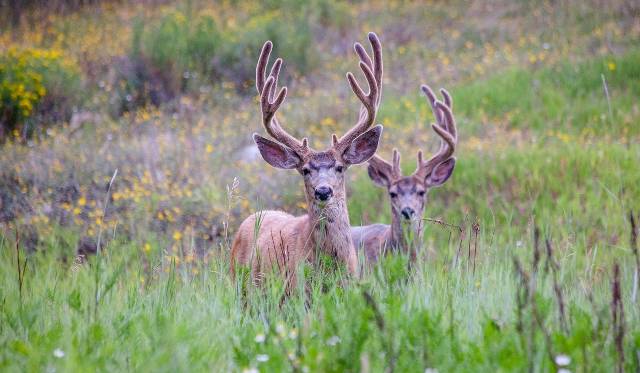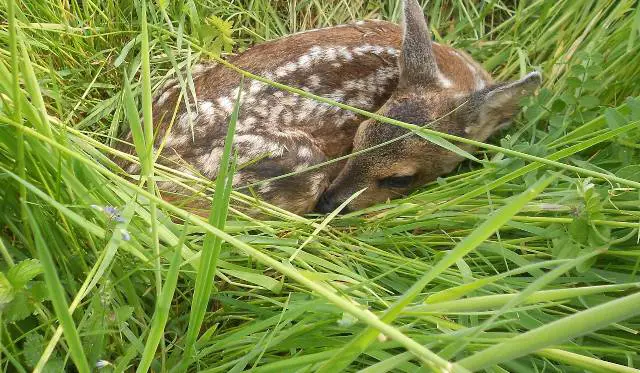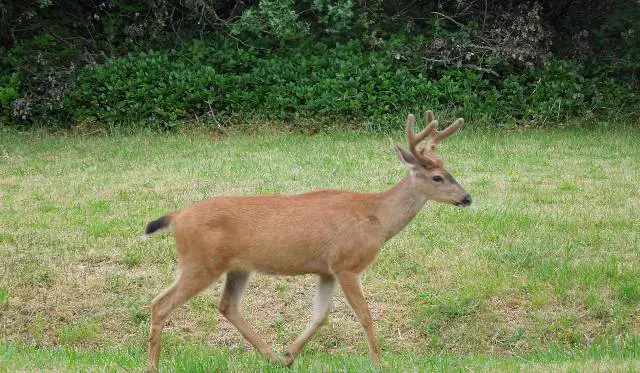As a deer hunter, its important that you have an understanding of deer grasses and what is the best grass for deer. Deer are herbivores and their diet mainly consists of grasses, leaves, and other vegetation. Deer grass provides them with essential nutrients, cover, and habitat.

Deer grasses are a source of food, but the grass also plays a crucial role in maintaining a healthy ecosystem. Increase your chances of hunting success by understanding the types of grasses and shrubs that deer prefer and how they you can increase your chances of hunting success.
Contents
Why Deer Need Grasses in Their Diet
Deer are known to be herbivores and consume a variety of plant-based foods, including grasses. Grasses are an essential part of a deer’s diet as they provide the necessary nutrients required for their growth and development.
Deer feed on both crops and eat grass throughout the year, but their consumption increases during the autumn season when other vegetation is scarce.
Nutritional Value of Grasses for Deer
Grasses are a rich source of nutrients for whitetail deer, providing them with essential minerals and vitamins. They are also a good source of protein and energy.
The protein content in grasses varies depending on the species and the time of year. During the growing season throughout spring and summer, grasses have higher protein content, making them an ideal food source for deer.
Role of Grasses in a Deer’s Habitat
Grasses are in important element in a deer’s habitat. They provide predator cover, movement cover, and shelter for deer, which helps them to hide and stay safe. Grasses also provide great habitat areas for nesting, nursing, and thermal protection.
Grasses also provide a habitat for insects and other small animals, which are an essential part of a whitetail deer’s diet. Additionally, grasses help to maintain the soil quality and prevent soil erosion.
Identifying Deer Grasses
Types of Grasses Preferred by Deer
Deer are known to prefer certain types of grasses over others. They tend to prefer grasses that are tall and have a coarse texture. Some of the grasses that deer tend to prefer include Big Bluestem, Indian Grass, Switchgrass, and Little Bluestem. These are all native grasses to North America.
Tips for Identifying Grasses in the Field
Identifying grasses in the field can be challenging, but there are a few tips that can help. One of the most important things to look for is the shape of the seed head. Different grass species have different seed head shapes, and this can be a key characteristic for identification.
Another important characteristic is the leaf blade. Some grasses have flat leaves, while others have rolled leaves. The texture of the leaf blades can also be important, as some grasses have rough or hairy leaves.
Common Grasses Found in Deer Habitats
There are many different grasses that can be found in deer habitats. Some of the most common grasses include:
- Deer Tongue Grass (Dichanthelium clandestinum): This grass is native to North America and can be found in prairies, savannas, and other grasslands. Deer Tongue grass is a warm-season perennial grass that typically grows up to 2 to 4 feet tall. The leaves of the grass are long and narrow and have a green color. The root system is fibrous and shallow, which makes it easy to uproot.
- Height: 2′ – 4′
- Color: Green
- Season: Warm
- Sun: Full
- Soil Moisture: Medium to Wet
- Little Bluestem (Schizachyrium scoparium): This grass is native to North America. It has a fine texture and can grow up to four feet tall. Leaves are green with a stem with a blueish base.
- Height: 2′ – 4′
- Color: Green, Blueish Base
- Season: Warm
- Sun: Full
- Soil Moisture: Dry to Medium
- Big Bluestem (Andropogon gerardii): This grass is native to North America and can be found in the eastern two thirds of the United States. It is a tall cover grass growing up to 10 feet with a coarse texture, making it a favorite of deer. Leaves are green and the stem has a blueish base.
- Height: 4′ – 10′
- Color: Green, Blueish Base
- Season: Warm
- Sun: Full
- Soil Moisture: Medium to Wet
- Switchgrass (Panicum virgatum): This grass is native to North America and is an excellent windbreak and cover grass. It has a fine texture and can grow up to seven feet tall.
- Height: 3′ – 7′
- Color: Green
- Season: Warm
- Sun: Full
- Soil Moisture: Medium to Wet
- Indian Grass (Sorghastrum nutans): This grass is native to North America and can be found in prairies, savannas, and other grasslands. It is tall with a coarse texture serving as great cover for deer.
- Height: 3′ – 6′
- Color: Green, Plume-like bronze heads
- Season: Warm
- Sun: Full
- Soil Moisture: Dry to Medium

Best Grasses for Deer
Deer are natural grazers and will feed on a wide variety of vegetation, including grasses. However, not all grasses and trees are created equal when it comes to providing free deer food and cover for deer.
Best Grass for Deer to Eat
Deer prefer to graze and eat grass that are high in nutrients and easy to digest. Wintergrass, Rescue Grass, and Sedges are three grasses that are known to be a frequented by deer. Cool season grasses like Wintergrass is common in the northern United States and is high in protein and energy.
Rescue is a warm-season grass that is native to Europe and is also high in nutrients. Sedges are another type of grass that deer eat and love.
Best Grass to Plant for Deer
When it comes to planting grasses for deer, switchgrass is the best option. Switch grass is a tall-growing grass that provides excellent cover and shelter for whitetail deer. It is also relatively easy to grow and is resistant to drought and disease. Other grasses that are good for planting for deer include Big Bluestem and Indian Grass.
Tall Growing Grass for Deer Cover
In addition to providing food, grasses can also serve as thick cover and shelter for white tailed deer. Tall-growing grasses such as Switchgrass, Big Bluestem, and Indian Grass are excellent for this purpose. These grasses provide cover for deer to hide from predators and seek shelter from the elements.
When planting grasses for cover, it is important to plant them in clumps or patches to create a more natural-looking habitat. By planting a variety of grasses, you can create a diverse habitat for attracting deer and supporting a healthy deer population.
Hunting Nearby Whitetail Deer Grasses
Grasses can provide important cover and shelter for deer in their habit, making them a prime location for hunters to set up. You can also revise your hunting strategies for hunting in areas with limited grasses.
Best Practices for Setting Up Near Grasses
Consider the following best practices when setting up near grasses:
- Scout the area: Before setting up, scout the area to identify the location of grasses and any deer trails nearby. This will give you a better idea of where to set up and what to expect in terms of deer traffic.
- Choose the right location: Look for areas where grasses provide cover and shelter for deer. This could be near a water source or in areas where there is a natural funnel for deer to travel through.
- Use scent control: When setting up near grasses, it’s important to use scent control to avoid alerting deer to your presence. This could include using scent-free clothing and scent control products. Minimize deer deterrents such as scent and noise.
- Stay concealed: When setting up near grass, it’s important to stay concealed. This could include using a ground blind or natural cover to blend in with the environment.
Strategies for Hunting in Areas with Limited Grasses
In areas with limited grasses, it’s still possible to hunt for deer. Consider the following strategies:
- Look for alternative cover: In areas with limited grasses, look for alternative cover that deer may be using. This could include thickets, brush, or other natural cover.
- Use decoys: Decoys can be an effective tool for drawing deer into an area. Consider using a decoy to attract deer to your location (if legal in your area).
- Create your own cover: If there is no natural cover in the area, consider creating your own. This could include using brush or other natural materials to create a makeshift blind.
- Stay patient: In areas with limited cover, it may take longer for deer to travel through. Stay patient and look for the right opportunity to present itself.
By following these best practices and strategies, hunters can increase their chances of success when hunting near grasses and weeds. Remember to always respect wildlife and follow local hunting regulations.

Best Grass For Deer: FAQs
What is the best grass for deer bedding area?
Switchgrass is a great grass for deer bedding areas. It provides excellent cover and nesting habitat for deer, and it is also a great source of food for them. Other wild grass options include Big Bluestem and Indian Grass, which also provide good cover and food.
Will deer eat grass seed?
Yes, deer will eat grass seed, especially if they are hungry and there is not much else available. However, they prefer to eat the leaves and stems of grasses, rather than the seeds. So, if you want to attract deer to your property, it is best to plant grasses that deer eat.
Do deer like to bed in switchgrass?
Yes, deer like to bed in switchgrass. It provides excellent cover and nesting habitat for them, and it also provides a good source of food. Switchgrass is on of many warm season grasses that grows tall and dense, making it an ideal choice for deer bedding areas.
Do deer hide in tall grass?
Yes, deer often hide in tall grass. It provides excellent cover and protection for them, especially when they are bedded down. Tall thick grass also provides a good source of food for deer, as they can browse on the leaves and stems.
When to mow fields for optimal deer habitat?
To create optimal deer habitat, it is best to mow fields in late summer or early fall. This allows the grasses to grow tall and provide good cover and nesting habitat for deer. It also allows the grasses to produce seeds, which provides a good source of food for deer during the winter months. Mowing the land too early or too late can have a negative impact on deer habitat.